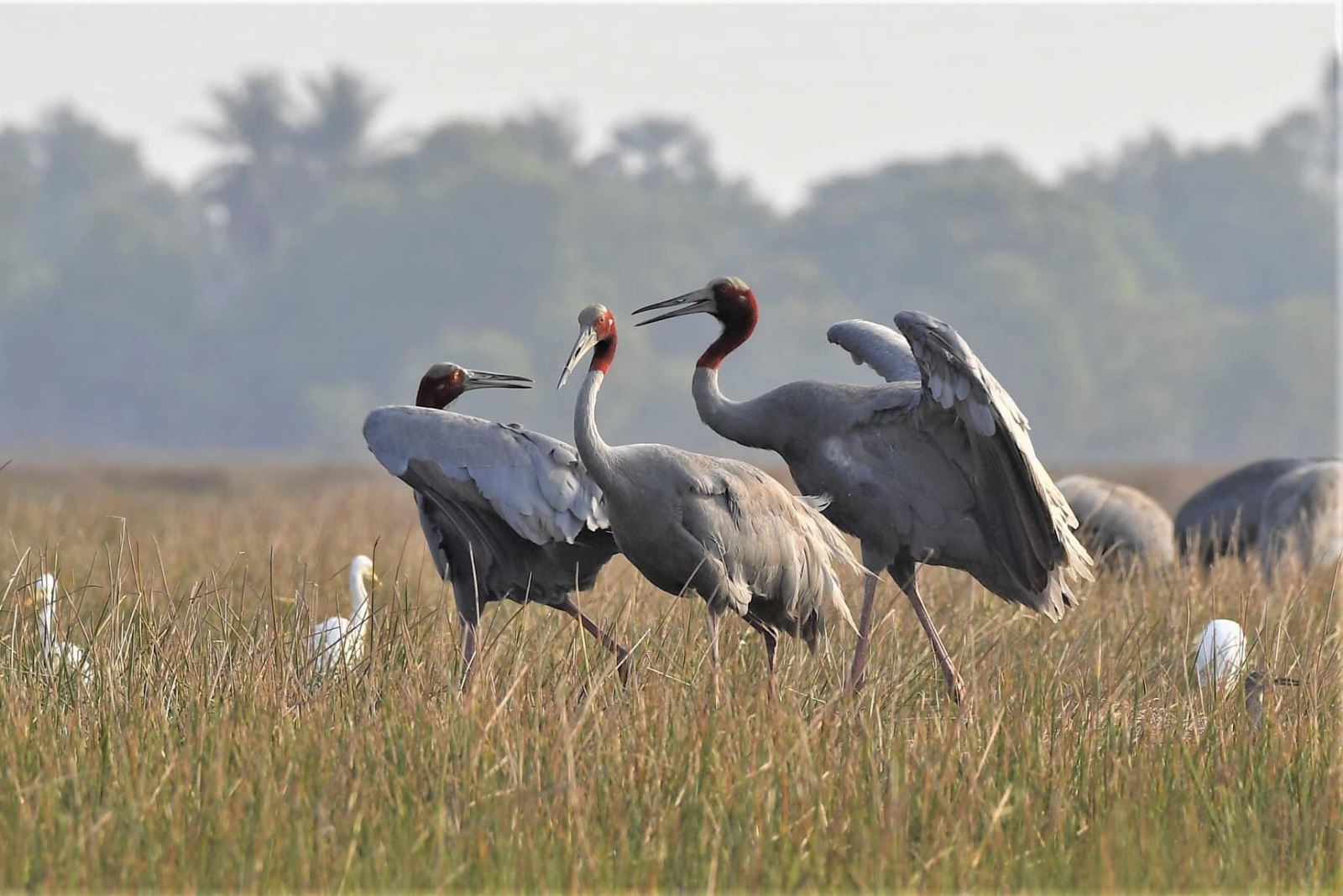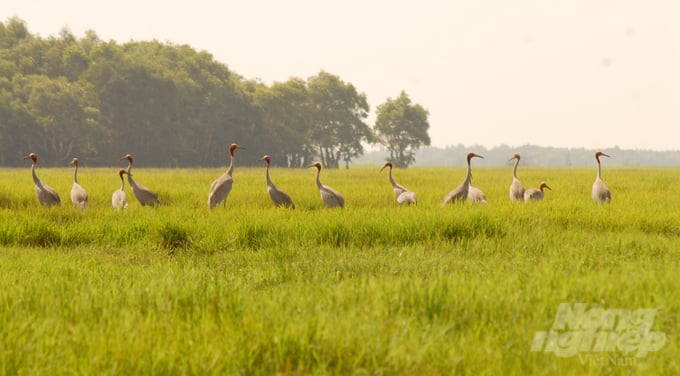November 27, 2025 | 19:11 GMT +7
November 27, 2025 | 19:11 GMT +7
Hotline: 0913.378.918
November 27, 2025 | 19:11 GMT +7
Hotline: 0913.378.918

In recent years, climate change and the environment have become complicated. This indirectly causes the herd of red-crowned cranes in Southeast Asia and Vietnam to decrease.
Scientists have discovered at least five types of Eleocharis atropurpurea in the Mekong Delta. However, only one of these species – Eleocharis atropurpurea – is a favorite food of the cranes. This is also the Eleocharis atropurpurea with the smallest and shortest stalk, about the size of a needle.
Due to its small shape and lack of luxuriant branches, it is difficult for Eleocharis atropurpurea to compete with other grass species. This species can only live in harsh places where other plants cannot grow. For example, in heavily alkaline soil, acidity is many times higher than in normal soil.
Several decades ago, when the dry season began, the seeds of Eleocharis atropurpurea sprouted, despite the rapid decrease in the amount of water in the soil due to heat, wind, and evaporation. Within two months, they multiply in density and accumulate nutrients to flower, bear fruit, and create tubers in the soil.
The fields are dry at the end of the dry season, and very few creatures can survive. Eleocharis atropurpurea becomes the sole food source for the entire ecosystem during the harsh dry season on heavily alkaline soils. Without them, other species cannot exist. It is not an exaggeration to say that metal is the main species in this ecosystem.
Previously, when the area of Dong Thap Muoi in general and Tram Chim National Park had not yet dug canals, cut ditches, or built dikes to keep water to reduce the risk of fire in grasslands, cranes still traveled thousands of kilometers to come here. They work hard to find tiny needles to make food to live through the dry season.
However, about ten years ago, according to Mr. Nguyen Hoang Minh Hai, Head of the Research and International Cooperation Department of Tram Chim National Park, people in this area devoted themselves to building canals and preserving water. Changes in soil and water quality lead to a decline in Eleocharis atropurpurea. From thousands of red-crowned cranes until 2021, only three individuals remain in Tram Chim.
From 2022 until now, Dong Thap province has not recorded any cases of red-crowned cranes returning.
“In recent years, climate change and the environment have become complicated. This indirectly causes the herd of red-crowned cranes in Southeast Asia and Vietnam to decrease. However, I think the most important cause is still the change in water levels in the area," Mr. Hai shared.

The Red-crowned Crane Conservation and Development Project is implemented by Dong Thap Province, with the hope of creating a large population of cranes as well as attracting wild cranes to Tram Chim National Park. Photo: Hoang Vu.
According to the scientific expert's explanation, the change in water level leads to the failure of the first link in the food chain in Tram Chim in the dry season - Eleocharis atropurpurea - to develop. For the red-crowned cranes to return, rebuilding the Eleocharis atropurpurea beaches is necessary. But to do that, it is essential to regenerate and maintain the water level as the inherent ecosystem.
The principle is the same, but Mr. Hai said this process is complicated because Eleocharis atropurpurea only grows under certain conditions. Too much rain or sunshine, or too much flooding, Eleocharis atropurpurea can't rise.
In parallel with cooperating with Thailand to re-release some red-crowned cranes at Tram Chim, scientists have also implemented many cooperation programs with institutes, schools, and international organizations to regenerate the environment for Eleocharis atropurpurea to grow, especially in the dry season.
"If we focus solely on releasing the cranes without creating a suitable environment for them, but directly on the Eleocharis atropurpurea beaches, then we may not be sincere about conservation. Red-crowned cranes must feel and see clearly. This is a living space for them, "said Mr. Hai.
In the upcoming time, Tram Chim National Park will submit to Dong Thap Provincial People's Committee a master plan to synchronously improve the soil and water environment and the buffer zones around the garden.
Along with that, Tram Chim National Park has developed a plan to preserve cranes until 2030, with a vision to 2050, in which special emphasis is placed on propaganda and education for people so that they know the meaning and importance of conservation activities.
"We are also building information pages about red-crowned cranes and also calling for the participation of associations, associations, socio-political organizations in the locality and the country. A cooperation project with NGOs is also planned. This is the basis for the parties to join hands, build trust with each other and improve operational efficiency in the future", the representative of Tram Chim National Park emphasized.
Translated by Ha Phuc

(VAN) According to Mr. Vo Minh Thanh, Director of the Tay Ninh Department of Agriculture and Environment, Resolution 57 has created a new development pathway for the locality, shifting from traditional toward modern agriculture.
/2025/11/26/4909-2-154329_878.jpg)
(VAN) Pearl grouper farming in HDPE cages not only delivers economic efficiency but also contributes to protecting the environment, creating jobs, and promoting marine-based experiential tourism.

(VAN) The model of making a living under the forest canopy through the agroforestry system in Van Son commune, Bac Ninh province, is expected to generate an annual income of approximately VND 30 million/ha.

(VAN) Many enterprises in Can Tho are harnessing natural energy and reducing greenhouse gas emissions in their production processes, thereby contributing to the promotion of a sustainable green transition.
/2025/11/24/3536-2-112800_176.jpg)
(VAN) Dong Nai now has tens of thousands of hectares of forests certified for sustainable management, and this area will continue to be expanded in the coming period.

(VAN) Vinh Ha hamlet (Dai Xuyen commune, Hanoi) is shifting away from small-scale farming as households adopt bioscurity into their breeder chicken models.

(VAN) Heavy rains make aquatic species more vulnerable to disease. Proactive water management and high-tech systems help farmers prevent outbreaks and protect yields.